Perimeter Formulas
About Perimeter Formulas
A shape's perimeter, also known as the outline, is the path or boundary that surrounds it. Different types of shapes are encountered in geometry, ranging from 2D to 3D shapes. The formulas for numerous 2-d shapes in geometry are covered by perimeter formulas. Let's go over the various formulas for different shapes and solve a few cases.
Meaning of Perimeter Formulas
By summing the side lengths of the 2-d shape, perimeter formulas are employed to calculate the distance around it. The total length of the sides of various shapes is referred to as the perimeter. If we know the shape's dimensions, we can calculate the perimeter formula. Depending on the shape of the item, each polygon has a distinct perimeter formula. The graphic below depicts all of the geometry formulas for various shapes.
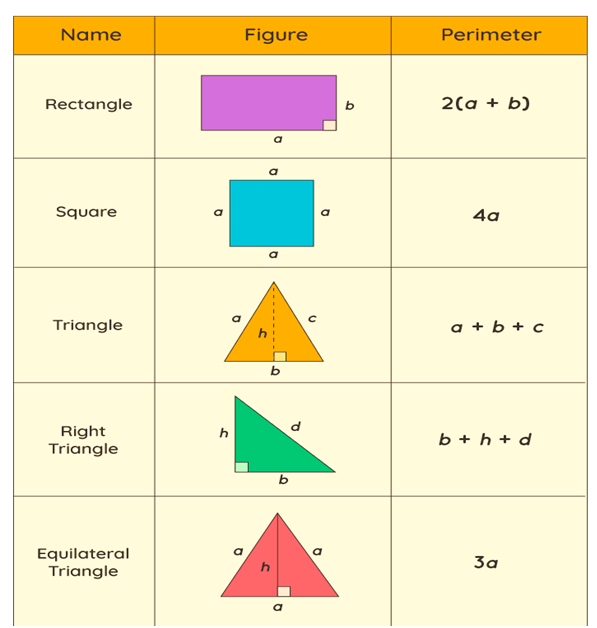
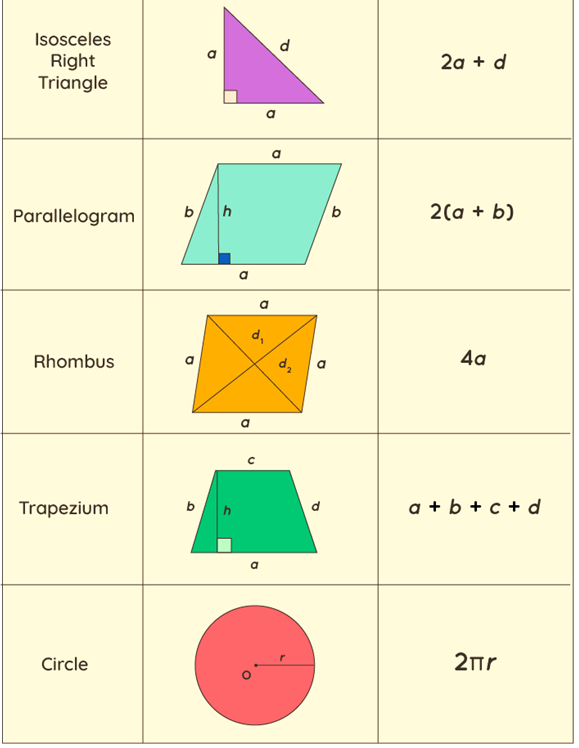
Perimeter Formula of Different Shapes
The perimeter formula is the sum of all the sides of any geometric shape. The perimeter formula for various shapes in geometry varies based on the shape and size. Let's look at the formulas for these shapes' perimeters.
Perimeter Formula of a Square
Any geometric shape's perimeter is equal to the sum of its sides. In geometry, the perimeter formula for distinct shapes changes depending on their shape and size. Let's look at the perimeter calculations for these forms.
The perimeter of a Square
(P) = 4 × Side units
Perimeter Formula of a Rectangle
The perimeter formula for a rectangle is determined by the distance covered by the complete rectangle, i.e. the border or all four sides. 2l + 2b = 2(l+b) A rectangle's perimeter is equal to double the sum of its length and width. As a result, the formula for calculating the perimeter of a rectangle is:
The perimeter of a Rectangle
Where,
- l - length of the rectangle
- b - the breadth of the rectangle
Perimeter Formula of the Triangle
The perimeter formula for a triangle can be computed by adding all of the triangle's sides, in this example all three sides. For different sorts of triangles, different perimeter formulas are employed. However, the general formula for calculating a triangle's perimeter is:
The perimeter of a Triangle = Sum of all 3 sides
The perimeter formulas of different types of triangles are:
- Perimeter of the Scalene Triangle = a + b + c, where a, b, and c are the three different sides
- Perimeter of Isosceles Triangle = 2a + b, where a is the length of each of the two sides of equal length and b is the third side.
- Perimeter of Equilateral Triangle = 3 × a, where a is the length of each side of the triangle
- Perimeter of Right Triangle = p + b + h or p + b + √(p2 + b2), where h is the hypotenuse of a right triangle, p is perpendicular of a right triangle, and b is the base of a right triangle
- Perimeter of Right Isosceles Triangle = h + 2l, where h is height and l is the length
Perimeter Formula of a Parallelogram
The perimeter formula for a parallelogram is the sum of all sides that are equal to one another. However, if the sides of the object are not given but the diagonals or an angle are, the perimeter formula of a parallelogram can be obtained. As a result, the formula for calculating a parallelogram's perimeter is:
- Perimeter of Parallelogram (with sides), P = 2 (a + b), where a & b are the two adjacent sides
- Perimeter of Parallelogram (with one side and diagonals), P = 2a + √(2x2 + 2y2 - 4a2), where a is one side & x and y are the diagonals
- Perimeter of Parallelogram (with side, height, and angle), P = 2a + 2h / sin θ, where a is the side, h is the height, and θ is the angle
Perimeter Formula of the Circle
A circle's perimeter formula has two primary components: two constants and one radius of the circle. The perimeter of a circle is equal to its circumference, and the formula for calculating the perimeter or circumference of a circle is:
- Perimeter of a Circle = 2 π r
- = π d
Where,
- r - radius of the circle
- d - diameter of circle
- π(pi) - 3.412
Perimeter Formula of the Rhombus
A rhombus' perimeter formula is calculated by summing the lengths of all of the shape's sides. The formula for calculating perimeter of a rhombus has two parameters: when the sides are supplied and when the angles are given. As a result, the formula for calculating the perimeter of a rhombus is:
- Perimeter of a Rhombus (with sides), P = 4a, where a is the length of the sides
- Perimeter of a Rhombus (with angles), P = 2√(d1)2+(d2)2, where d1 and d2 are the lengths of the diagonals
Perimeter Formula of a Trapezoid
The perimeter of a trapezoid is calculated by adding the lengths of all four sides of the object. A trapezoid's perimeter formula ensures that it covers the whole boundary of the trapezoid. As a result, the formula for calculating a trapezoid's perimeter is:
Perimeter of a Trapezoid,
P = Sum of all sides = a + b + c + d,
where a, b, c, and d are the lengths of the sides
Perimeter Formula of a Kite
A kite's perimeter is measured by adding all of its sides, and the distance is derived by adding the sides of each pair. As a result, the formula for calculating a kite's perimeter is:
Perimeter of a Kite, P = 2(a+b),
where a and b are the lengths of the two pairs of kites
Perimeter Formula of Polygons
Because polygons are closed plane shapes, their perimeters are also in a two-dimensional plane. A polygon's perimeter formula can be calculated by measuring the polygon's total length. Polygon perimeters are determined in two ways: with respect to regular polygons and with respect to irregular polygons. The perimeter of a regular polygon is calculated using the following formula:
Regular Polygons:
- Perimeter of a Hexagon = 6 × (length of one side)
- Perimeter of a Pentagon = 5 × (length of one side)
Irregular Polygons:
Perimeter of Irregular Polygons = Sum of all sides
Get a List of Maths Formulas on one page
Download the pdf of Perimeter Formula
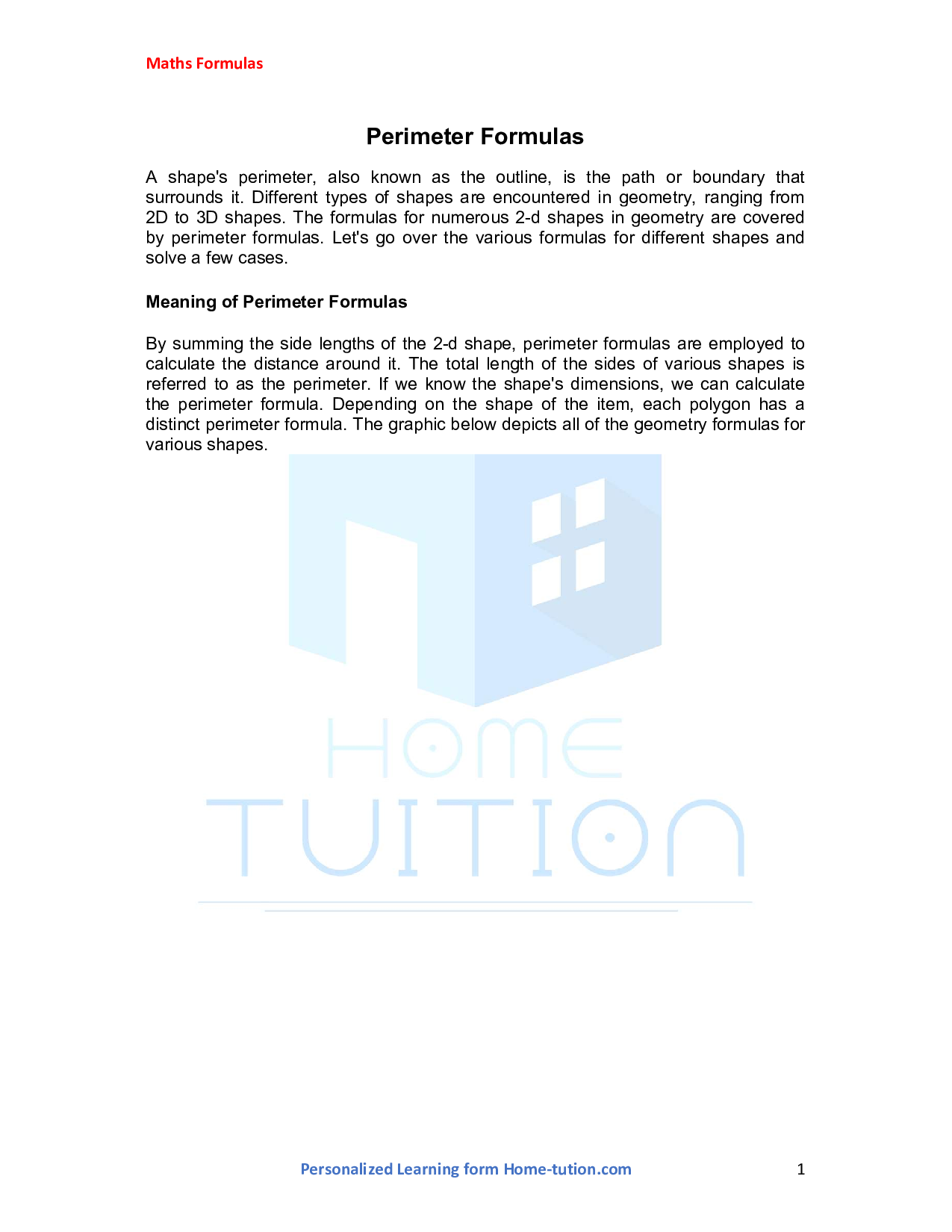
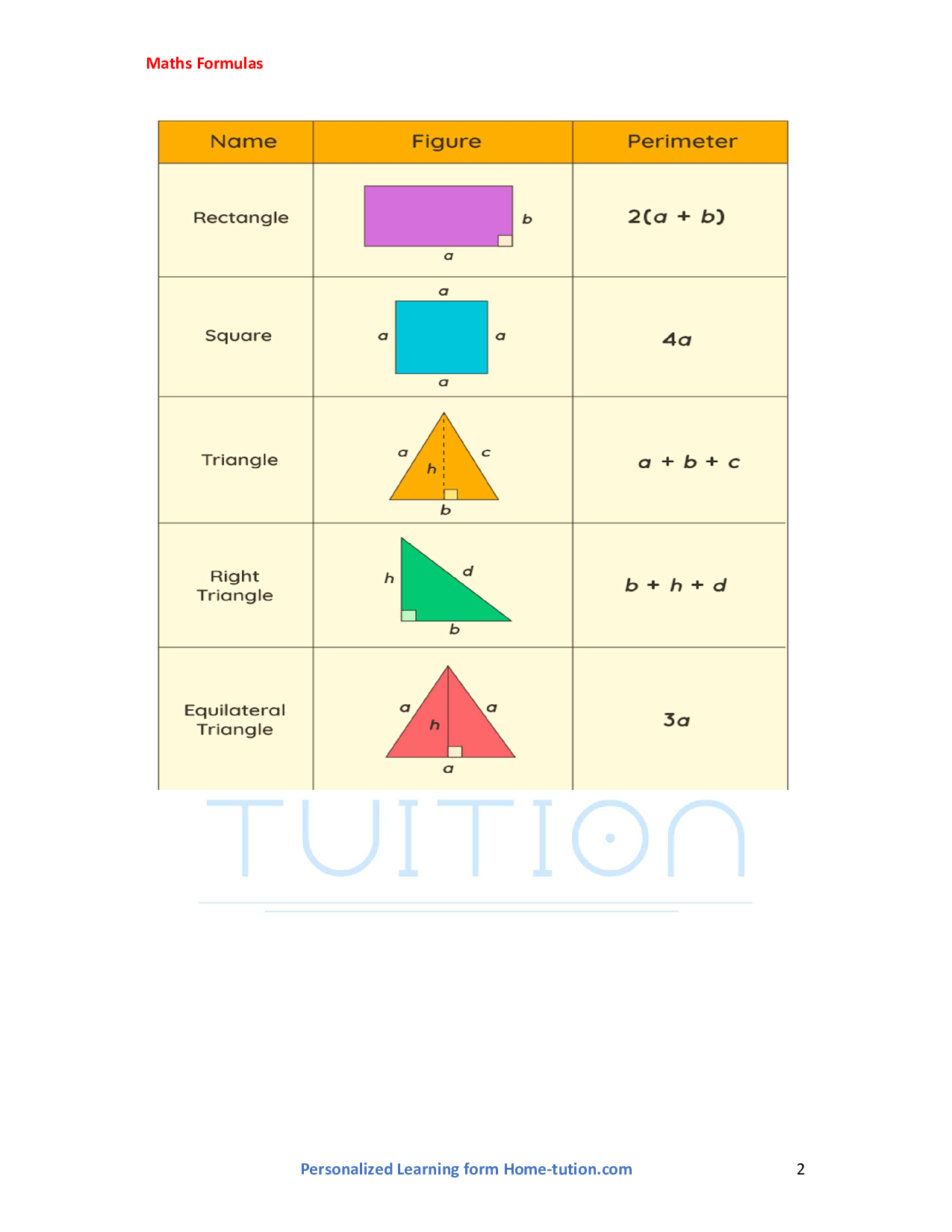
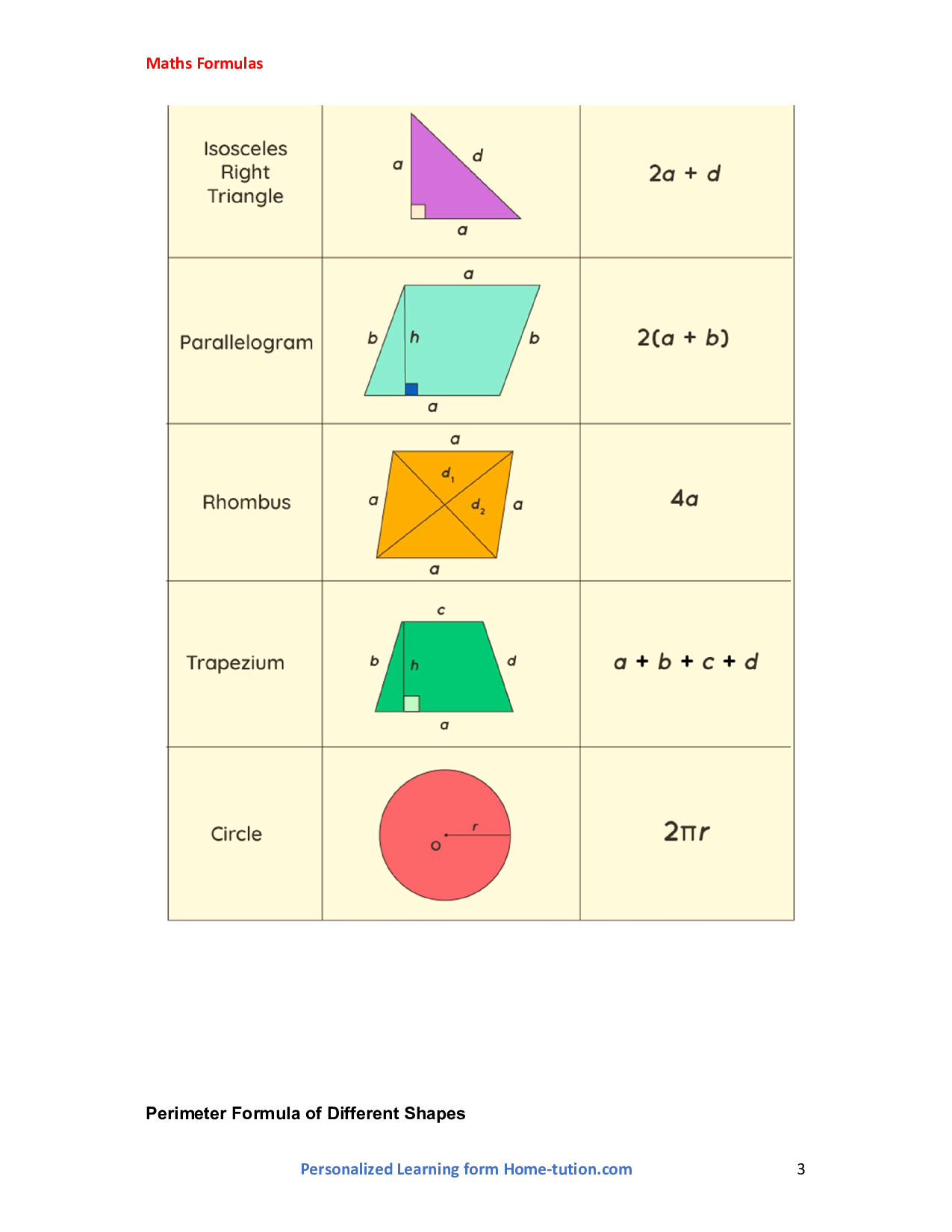
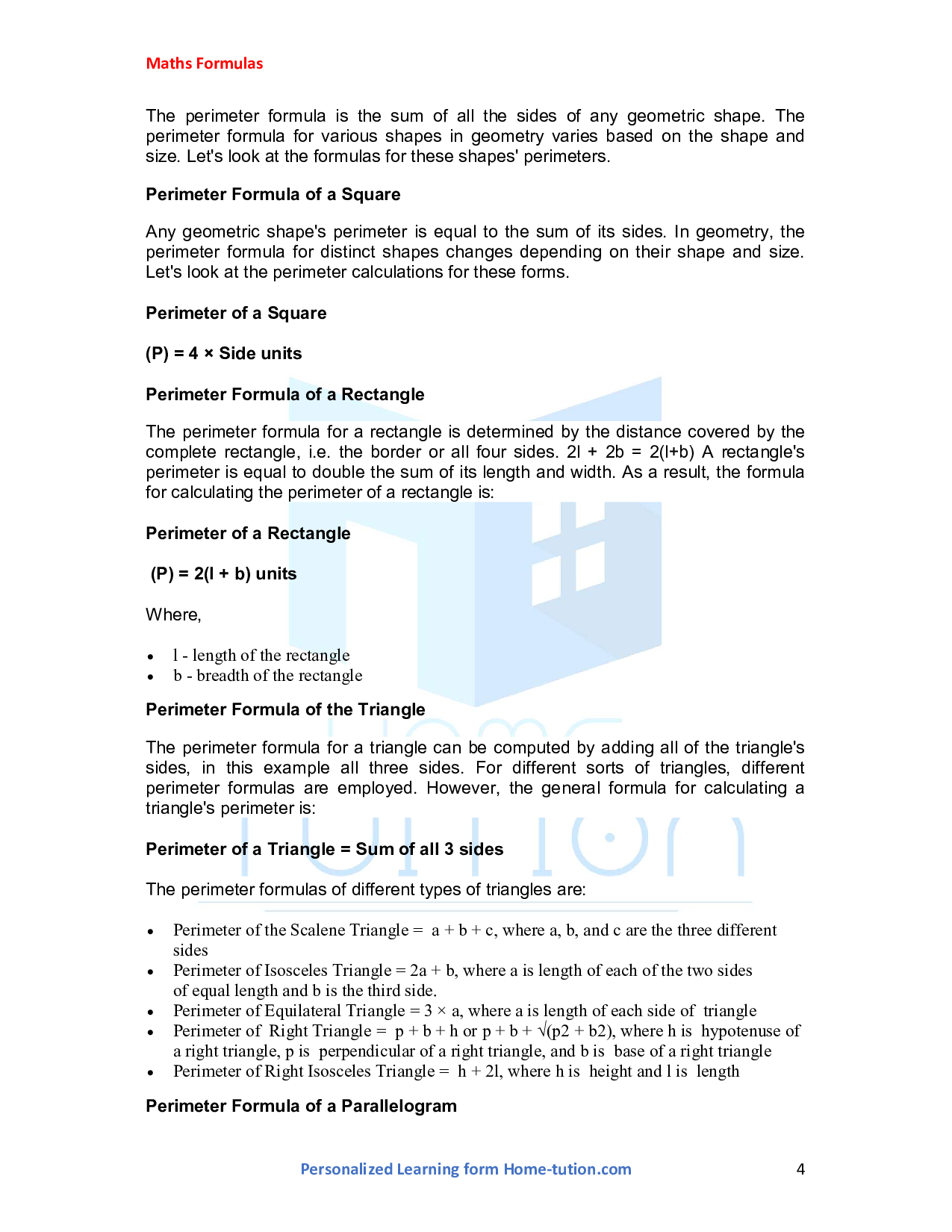
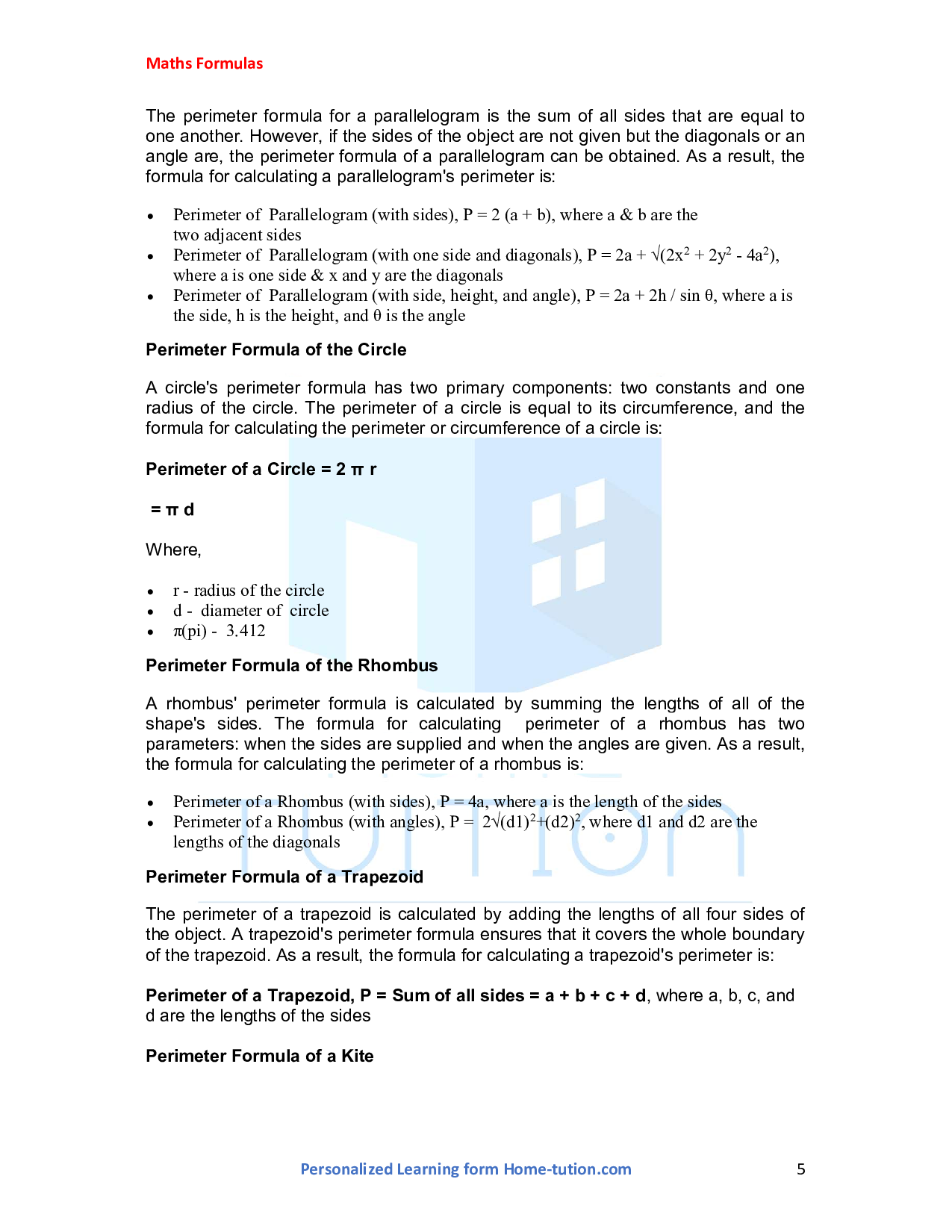

Related Links
- A plus B Whole Square
- A Plus B Whole Cube Formula
- A Minus B Whole Square
- A minus B Whole Cube Formula
- X plus 1 whole cube Formula
- 2cosA cosB Formula
- 3D Distance Formula
- 30-60-90 Formula
- 90 Degree Angle Formula
- a3 plus b3 Formula
- a3 - b3 Formula
- a2+b2+c2 Formula
- Addition Formula
- All Algebra Formula in One sheet
- Algebraic Sequence Formula
- All Circle Formulas
- Altitude of a Triangle Formula
- Amplitude Formula
- Angle Bisector Theorem
- Angle Difference Formula
- Angles Formulas
- Annuity Formula
- ANOVA Test
- Antiderivative Formula
- APY Formula
- Arccot Formula
- Arc Length
- Arctan Formula
- Area of a circle
- Area of a sector of a circle formula
- Area under the curve formula
- Arithmetic Sequence Recursive Formula
- Arithmetic Mean Formula
- Arithmetic Sequence Explicit Formula
- Arithmetic Sequence Formula
- ASA Formula
- Associative Property Formula
- Asymptote Formula
- A Union B Formula
- Average Deviation Formula
- Average Formula
- Average Rate of Change Formula
- Average speed formula
- Axis of the Symmetry
- Basic Algebra Formula
- Cosec Cot Formula
- Baye's Formula
- Binary to Decimal
- Binomial Distribution Formula
- Binomial Expansion
- Binomial Theorem Formula
- Calculus formulas
- Calculus Formulas
- Celsius Formula
- Celsius to Fahrenheit
- Celsius to kelvin
- Centimeter Square to Meter Square Formula
- Central Angle of a Circle Formula
- Central Limit Theorem
- Central Tendency Formula
- Centroid Formula
- Centroid of a Trapezoid Formula
- Chain Rule And Composite Functions
- Change of Base Formula
- Chi-square formula
- Circle Graph Formula
- Clock Angle Formula
- Coefficient of Variation
- Cofactor Formula
- Coin Toss Probability Formula
- Combinations Formula
- Common Ratio Formula
- Commutative Property Formula
- Completing the Square Formula
- Complex Number Formula
- Conditional probability Formula
- Cone Height Formula
- Confidence Interval Formula
- Consecutive Integers Formula
- Continuous Compounding Formula
- Convert Millimeter to Inches Formula
- Correlation Coefficient Formula
- Cos Inverse Formula
- Cos Square Theta Formula
- Cosecant Formula
- Cost Price Formula
- Cot-Tan Formula
- Cotangent formula
- Covariance Formula
- Cpk Formula
- Cross product formula
- Cube formula
- Cube Root Formula
- Cubic Equation Formula
- Degrees to Radians
- Double Angle Formulas
- Quadratic Function
- Quadrilateral Area Formulas
- Quadrilateral Formulas
- Quarterly Compound Interest Formula
- Quartile Formula
- Quarts to liters formula
- Quotient Rule Formula
- R Squared Formula
- Radians to Degrees
- Radical
- Radius of Curvature Formula
- Radius
- Range Formula
- Rate formula
- Rate of Change Formula
- Rate of Return Formula
- Ratio Analysis Formulas
- Ratio Formula
- Rational Numbers Formula
- Reciprocal Formula
- Recursive Formula
- Reduction Formula
- Regular Hexagon Formula
- Relative Change Formula
- Relative Error Formula
- Relative Frequency Formula
- Relative Standard Deviation Formula
- Remainder Formula
- Lagrange Interpolation Formula
- Lateral Area Formula
- Lateral Surface Area of a Cube
- Law of Cosines
- Law of Sines
- Least Common Multiple
- Limit Formula
- Linear Approximation Formula
- Linear Equation Formula
- Linear Function Formula
- Linear Interpolation Formula
- Litres to gallons formula
- Log Formulas
- Factorial
- Factoring Trinomials Formula
- Factorization Formula
- Fahrenheit Equation
- Fahrenheit to Celsius
- Fahrenheit to Kelvin
- Fibonacci Sequence Formula
- Fibonacci Sequence
- Foil Formula
- Foot To Meter Formula
- Formula For 180 Degree Rotation
- Formula For Absolute Value
- Formula For Adding Fractions
- Formula For Adding Consecutive Numbers
- Formula Arc Length
- Formula For Dividing Fractions
- Formula For Finding Angles
- Formula For Odd Numbers
- Formula For Period
- Formula For Squaring
- Isosceles Triangles Formulas
- Formula To Find x Intercept
- Fourier Series Formula
- Fractions Formula
- Frequency Distribution Formula
- Frequency Formula
- Frustum Of A Regular Pyramid Formula
- Frustum of Cone
- Function Formulas
- Function Notation Formula
- Future Value Compound Interest Formula
- Future Value Simple Interest Formula
- G To Kg Formula
- GCD Formula
- GCF Formula
- Geometric Area Formula
- Geometric Distribution Formula
- Geometric Mean Formula
- Geometric Sequence Formulas
- Geometric Series Formula
- Geometric Sum Formula
- Geometry Formulas
- Gradient Of A Line
- Grams To Kilogram Formula
- Great Circle Formula
- Gross Profit Formula
- Half Life Formula
- Harmonic Mean Formula
- HCF Formula
- Height Of A Parallelogram Formula
- Heron's Formula
- Hexadecimal To Decimal Formula
- Hexagon Formula
- How To Convert 20 Celsius Into Fahrenheit
- How To Convert Celsius Into Fahrenheit
- Hyperbola Formula
- Hyperbolic Functions Formula
- Hypotenuse Formula
- Implicit Differentiation Formula
- Independent Events Formula
- Infinite Geometric Series Formula
- Infinite Series Formula
- Integers Formulas
- Integration By Parts Formula
- Integration Formulas
- Integration of UV Formula
- Interest Formula
- Interest Rate Formula
- Interior Angle Formula
- Internal Rate of Return Formula
- Linear Interpolation Formula
- Interquartile Range(IQR) Formula
- Inverse Functions
- Inverse of Matrix
- Inverse Tangent Formula
- Inverse Trigonometric Formulas
- Inverse Variation Formula
- Inversely Proportional Formula
- Perimeter Of The Isosceles Triangle
- Sample Mean Formula
- Sample Size Formula
- Sample Standard Deviation Formula
- Sample Variance
- SAS Triangle Formula
- Scalene Triangle
- Scientific Notation Formula
- Secant Formula
- Selling Price Formula
- Long Division Formula
- Sequences and Series Formulas
- Semicircle Formulas
- Sequence Formulas
- Maclaurin Series Formula
- Magnitude of a Vector
- Sets Formulas
- Magnitude of Vector formula
- P(A/B) Formula
- Matrix Formula
- Mean Absolute Deviation Formula
- Parabola Formula
- Mean Deviation
- Parallel Lines Formula
- Parallelogram Formula
- Mean formula
- Pearson Correlation Formula
- Percent Composition Formula
- Mean Median Mode Formula
- Mean Value Theorem
- Median
- Midpoint Formula
- Miles to Km formula
- Percent Decrease Formula
- Measurement Formulas
- Miles to meter formula
- Percent Error
- Percent Difference Formula
- Percent Yield
- ml to l Formula
- Percentage Increase Formula
- Mode
- Monthly Compound Interest Formula
- Mph to m/s formula
- Percentile Formulas
- Multiple Angle Formulas
- Multiplication
- n Choose k Formula
- Perfect Cube Formula
- Natural Log Formula
- Perfect Square Formula
- NCR Formula
- Perfect Square Trinomial Formula
- Net Change Formula
- Net Income Formula
- Net Present Value Formula
- Perimeter Formulas
- Net Worth Formula
- Newton's Method Formula
- Nominal Interest Rate Formula
- Normal Distribution Formula
- nPr Formula
- Ordinary Annuity Formula
- Orthocenter Formula
- Perimeter Of A Circle Formula
- Z Score
- Perimeter Of A Kite Formula
- Perimeter of a Trapezoid Formula
- Yards to Meters Formula
- Permutation And Combination
- Y-Intercept
- Permutation Formula
- Work Formula
- What are Trigonometric Functions Formulas
- Weight formula
- Perpendicular Line Formula
- Phase Shift Formula
- Weighted Mean
- Weighted Average
- Pi Formula
- Point of Intersection Formula
- Washer Method Formula
- Point Slope Form
- Volume Formulas
- Vieta's Formula
- Venn Diagram Formula
- Vector Projection
- Vector formulas
- Poisson Distribution Formula
- Polygon Formula
- Polynomial Formula
- Variance Formula
- U Substitution Formula
- Unit Vector
- Population Change Formula
- Unit Rate Formula
- Unit Conversion
- Unit Circle
- Uniform Distribution Formula
- Population Mean Formula
- Trigonometry Formulas
- Triangular Pyramid Formula
- Triangle Formulas
- Trapezoidal Rule
- Trajectory Formula
- Total Interest Formula
- Time Formula
- The direction of a vector
- The Accuracy Formula and How to Calculate It
- Temperature Conversion
- T Distribution Formula
- Taylor Series Formula
- Taylor Polynomial Formula
- Tangent Line
- Tangent Formulas
- Tangent Circle Formula
- Tan Formula
- Tan2x Formula
- Surface-area-of-triangular-pyramid-formula
- Surface Area of a Square Prism
- Surface Area Formulas
- Supplementary Angles Formula
- Sum of Squares
- Sum of Perfect Squares Formula
- Sum of n Natural Numbers Formula
- Sum of Integers Formula
- Sum of Exterior Angles Formula
- Sum of Even Numbers Formula
- Sum of Cubes Formula
- Sum of Arithmetic Sequence Formula
- Sum of Angles Formula
- Summation Formulas
- Subtraction
- Stirling Formula
- Standard Form Formula
- Standard Deviation
- SSS Formula
- Square Root
- Square Footage Formula
- Speed formula
- Special Right Triangles
- Special Factoring Formulas
- Slope of the Secant Line Formula
- Slope Intercept Form
- Slope Formula
- Slant Height Formula
- Skewness Formula
- Sin Squared x Formula
- Sin Formula
- Sine Formula
- Sin Cos Tan
- Sin Cos Formulas
- Sin2x Formula
- Simpson's Rule
- Simple Interest
- Similar Triangles Formula
- Signal to Noise Ratio
- Sides of Triangle
- Shell Method Formula
- Rotation Formula
- Root Mean Square Formula
- Rise Over Run Formula
- Right Angled Triangle
- Riemann Sum Formula
- Rhombus Formula
- Reverse Percentages
- Revenue Formula
- Resultant Vector Formula
- Remainder Theorem
- Profit Margin Formula
- Profit Formula
- Profit and loss formula
- Product To Sum Formulas
- Area of Square Formula
- Product Rule
- Area of Trapezoid
- Basic Statistics Formula
- Current Formula
- Daily Compound Interest Formula
- De Moivre's Formula
- Exponential Decay Formula
- Decimal to Binary Formula
- Decimals Formula
- Definite Integral Formula
- Derivative Formula
- Diagonal of a Cube Formula
- Diagonal of a Parallelogram
- Diagonal of a Polygon Formula
- Diagonal of The Rectangle
- Probability Formula
- Prime Numbers Formula
- Diagonal of the Square
- Diagonals Formula
- Prime Factorization Formula
- Present Value Formula
- Present Discounted Value Formula
- Population Variance
- Diameter Formula
- Km to miles formula
- Diameter Of A Sphere Formula Using Volume
- Kilogram to newton formula
- Exterior Angle Theorem
- Difference of Cubes Formula
- Exponential Formula
- Difference of Squares Formula
- Exponential Growth Formula
- Exponential growth and decay formula
- Exponential Function formula
- Exponential Function
- Side Angle Side Formula
- Difference Quotient Formula
- Differential Equation Formula
- Dimensional Formula
- Discriminant Formulas
- Disk Method Formula
- Distance Formula
- Distributive Property Formula
- Exponential Equations
- Dividend Divisor Quotient Remainder Formula
- Exponential Distribution
- Exponential Decay Formula
- Division Formula
- Euler's Formula
- Expected Value Formula
- Dot product
- Euclidean Distance Formula
- Double Angle Formulas
- Equilateral Triangle Formula
- Equation of a circle formula
- Endpoint Formula
- Double Time Formula
- Empirical Rule Formula
- Empirical Probability Formula
- Ellipse Formulas
- Effective Interest Rate Formula
- Effective Annual Rate Formula
- Differentiation and Integration Formula
- Direct Proportion Formula
- Direct Variation Formula
- a2-b2 Formula
- Discount Formula
- Determinant Formula
- Pythagorean Triples Formula
- P-value Formula
- Proportion Formula
- P(A intersections B) Formula
- P(A union B)Formula
- Decimal to Hexadecimal
- Vertex Formula
- Area of Octagon
- Outlier Formula
- Distance Between Two Points Formula